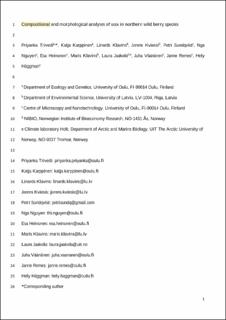Compositional and morphological analyses of wax in northern wild berry species
Trivedi, Priyanka; Karppinen, Katja; Klavins, Linards; Kviesis, Jorens; Sundqvist, Petri; Nguyen, Nga; Heinonen, Esa; Klavins, Maris; Jaakola, Laura; Väänänen, Juha; Remes, Janne; Häggman, Hely
Peer reviewed, Journal article
Accepted version
Date
2019-05-21Metadata
Show full item recordCollections
Abstract
Aerial surfaces of plants are covered by a waxy cuticle protecting plants from excessive water loss and UV light. In the present study, composition and morphology of cuticular waxes of northern wild berry species bilberry (Vaccinium myrtillus L.), lingonberry (V. vitis-idaea L.), bog bilberry (V. uliginosum L.) and crowberry (Empetrum nigrum L.) were investigated. Scanning electron microscopy (SEM) revealed differences in epicuticular wax morphology, and gas chromatography–mass spectrometry (GC–MS) analysis confirmed variation in chemical composition of cuticular waxes between the berry species. The dominant compounds in bilberry and lingonberry cuticular waxes were triterpenoids, while fatty acids and alkanes were the dominant ones in bog bilberry and crowberry, respectively. Wax extracted by supercritical fluid extraction (SFE) from industrial press cakes of bilberry and lingonberry contained linoleic acid and γ-linolenic acid as the dominant compounds. Furthermore, in vitro sun protection factor (SPF) of berry waxes depicted good UV-B absorbing capacities.
